Parametric Assessment of Pre-Monsoon Agricultural Water Scarcity in Bangladesh
Abstract
:1. Introduction
2. Study Area
2.1. Climate
2.2. Agriculture
2.3. Water Stress
3. Methodology
3.1. Framework of This Study
- Standardized precipitation index (SPI; [12]) during the pre-monsoon season was estimated from the long-term monthly rainfall record to assess the spatial distribution of the return periods of meteorological droughts. Rainfall was considered less available in the area with lower return period of meteorological drought and vice versa.
- Spatial distribution of groundwater depth was estimated by interpolating the average groundwater depth during the pre-monsoon season to measure the availability of groundwater resources.
- The ratio of low lift pump (LLP) used for surface water irrigation to groundwater abstraction wells was used as a proxy indicator to measure the contribution of surface water in irrigation during the pre-monsoon season.
- Spatial distribution of groundwater salinity for irrigation was calculated by interpolating the groundwater salinity data.
- The surface water salinity map prepared by Soil Resource Development Institute (SRDI) and was used to assess the spatial distribution of surface water salinity for irrigation.
- All the maps described in steps 1 to 5 were assigned weights using the catastrophe theory.
- Finally, all the maps were integrated into the map of agriculture water scarcity.
3.2. Data and Sources
3.3. Standardized Precipitation Index (SPI)
3.4. Catastrophe Theory
- The agricultural water stress depends on number of factors, depending on geographical context of a region. Therefore, agricultural water stress system is divided into number of subsystems each consist of an evaluation indicator system.
- The catastrophe model for the indicator system is determined based on the levels of which the evaluation indicators are decomposed. For example, the butterfly catastrophe model is used when an evaluation indicator is decomposed into four levels.
- A standardized method is used to convert the indicator values to dimensionless numbers in the range of 0 to 1 in order to remove the influence of range and units of different indicators.
- The catastrophe model is used to estimate the value of fuzzy membership function for standardized evaluation indicator values.
- The process is repeated to fuzzy membership function values of all indicators.
- The average of standardized indicator values is estimated as the weight of each control variable on state variable considering complementarity principle, which means the control variables can compensate each other.
3.4.1. Selection of Indicators
3.4.2. Standardization of Data
3.4.3. Normalization for Catastrophe Theory
3.4.4. Computation of Agricultural Water Scarcity
4. Results
4.1. Representation of Five Subsystems
4.2. Application of the Catastrophe Theory
5. Discussion
5.1. Water Scarcity in Southwest Bangladesh
5.2. Water Scarcity in Northwest Bangladesh
5.3. Adaptation of Water Scarcity
6. Conclusions
Acknowledgments
Author Contributions
Conflicts of Interest
References
- Organization for Economic Cooperation and Development (OECD). The OECD Environmental Outlook to 2050: The Consequences of Inaction; OECD and the PBL Netherlands Environmental Assessment Agency: Paris, France, 2012. [Google Scholar]
- International Food Policy Research Institute. Sustainable Food Security under Land, Water, and Energy Stresses (Chapter 3) 2012 Global Hunger Index; International Food Policy Research Institute: Washington, DC, USA, 2012. [Google Scholar]
- Anseeuw, W.; Alden, W.L.; Cotula, L.; Taylor, M. Land Rights and the Rush for Land: Findings of the Global Commercial Pressures on Land Research Project; International Law Commission: Rome, Italy, 2012; p. 72. [Google Scholar]
- United Nations. World Population Prospects: The 2012 Revision: Highlights and Advance Tables; Department of Economic and Social Affairs, Population Division: New York, NY, USA, 2013. [Google Scholar]
- Food and Agriculture Organization. How to Feed the World in 2050. In Proceedings of the Expert Meeting on How to Feed the World in 2050, FAO Headquarters, Rome, Italy, 24–26 June 2009. [Google Scholar]
- Wang, X.-J.; Zhang, J.-Y.; Shahid, S.; Xia, X.-H.; He, R.-M.; Shang, M.-T. Catastrophe theory to assess water security and adaptation strategy in the context of environmental change. Mitig. Adapt. Strateg. Glob. Chang. 2014, 19, 463–477. [Google Scholar]
- Khalid, I.; Mukhtar, A.; Ahmed, Z. Water scarcity in South Asia: A potential conflict of future decades. J. Polit. Stud. 2014, 21, 259–280. [Google Scholar]
- World Bank. Turn down the Heat: Climate Extremes, Regional Impacts, and the Case for Resilience—Full Report; World Bank: Washington, DC, USA, 2013. [Google Scholar]
- Economic and Social Commission for Asia and the Pacific. Statistical Yearbook for Asia and the Pacific 2011; Economic and Social Commission for Asia and the Pacific: Bangkok, Thailand, 2011; p. 287. [Google Scholar]
- Habiba, U.; Shaw, R.; Takeuchi, Y. Drought risk reduction through a socio-economic, institutional and physical approach in the northwestern region of Bangladesh. Environ. Hazard. 2011, 10, 121–138. [Google Scholar] [CrossRef]
- Vörösmarty, C.J.; McIntyre, P.B.; Gessner, M.O.; Dudgeon, D.; Prusevich, A.; Green, P.; Glidden, S. Global threats to human water security and river biodiversity. Nature 2010, 467, 555–561. [Google Scholar] [CrossRef] [PubMed]
- Mckee, T.B.; Doesken, N.J.; Kleist, J. The relationship of drought frequency and duration to time scales. In Proceedings of the 8th Conference on Applied Climatology, American Meteorological Society, Boston, MA, USA, 17–22 January 1993; Volume 17, pp. 179–183. [Google Scholar]
- Vicente-Serrano, S.M.; Beguería, S.; López-Moreno, J.I. A multi-scalar drought index sensitive to global warming: The standardized precipitation evapotranspiration index–SPEI. J. Clim. 2010, 23, 1696–1718. [Google Scholar] [CrossRef]
- Shafer, B.A.; Dezman, L.E. Development of a Surface Water Supply Index (SWSI) to Assess the Severity of Drought Conditions in Snowpack Runoff Areas. In Proceedings of the Western Snow Conference, Colorado State University, Fort Collins, CO, USA, 19–23 April 1982; pp. 164–175. [Google Scholar]
- Nalbantis, I.; Tsakiris, G. Assessment of hydrological drought revisited. Water Resour. Manag. 2009, 23, 881–897. [Google Scholar] [CrossRef]
- Palmer, W.C. Keeping track of crop moisture conditions, nationwide: The new Crop Moisture Index. Weatherwise 1968, 21, 156–161. [Google Scholar] [CrossRef]
- Narasimhan, B.; Srinivasan, R. Development and evaluation of Soil Moisture Deficit Index (SMDI) and Evapotranspiration Deficit Index (ETDI) for agricultural drought monitoring. Agric. For. Meteorol. 2005, 133, 69–88. [Google Scholar] [CrossRef]
- Keyantash, J.A.; Dracup, J.A. An aggregate drought index: Assessing drought severity based on fluctuations in the hydrologic cycle and surface water storage. Water Resour. Res. 2004, 40, W09304. [Google Scholar] [CrossRef]
- Barua, S. Drought Assessment and Forecasting Using a Non-Linear Aggregated Drought Index. Ph.D. Thesis, Victoria University, Melbourne, Australia, 2010. [Google Scholar]
- Alamgir, M.; Shahid, S.; Hazarika, M.M.; Nashrrullah, S.; Harun, S.B.; Shamsudin, S. Analysis of meteorological drought pattern during different climatic and cropping seasons in Bangladesh. JAWRA J. Am. Water Resour. Assoc. 2015, 51, 794–806. [Google Scholar] [CrossRef]
- Mohsenipour, M.; Shahid, S.; Chung, E.; Wang, X.-J. Changing Pattern of Droughts during Cropping Seasons of Bangladesh. Water Resour. Manag. 2018, 32, 1–14. [Google Scholar] [CrossRef]
- Shahid, S. Impacts of Climate change on irrigation water demand in Northwestern Bangladesh. Clim. Chang. 2011, 105, 433–453. [Google Scholar] [CrossRef]
- Intergovernmental Panel on Climate Change. Impacts, Adaptation, and Vulnerability; Cambridge University Press: Cambridge, UK, 2007. [Google Scholar]
- Mirza, M.M.Q. Three recent extreme floods in Bangladesh: A hydro-meteorological analysis. In Flood Problem and Management in South Asia; Springer: Berlin, Germany, 2003; pp. 35–64. [Google Scholar]
- Dasgupta, S.; Kamal, F.A.; Khan, Z.H.; Choudhury, S.; Nishat, A. River Salinity and Climate Change: Evidence from Coastal Bangladesh; Policy Research Working Paper; World Bank: Washington, DC, USA, 2014. [Google Scholar]
- Karima, M.F.; Mimura, N. Impacts of climate change and sea-level rise on cyclonic storm surge floods in Bangladesh. Glob. Environ. Chang. 2008, 18, 490–500. [Google Scholar] [CrossRef]
- Falkenmark, M. The massive water scarcity now threatening Africa: Why isn’t it being addressed? Ambio 1989, 18, 112–118. [Google Scholar]
- Jun, K.S.; Sung, J.Y.; Chung, E.S.; Lee, K.S. Development of spatial water resources vulnerability index considering climate change impacts. Sci. Total Environ. 2011, 409, 5228–5242. [Google Scholar] [CrossRef] [PubMed]
- Sullivan, C. Calculating a water poverty index. World Dev. 2002, 30, 1195–1210. [Google Scholar] [CrossRef]
- Forouzani, M.; Karami, E. Agricultural water poverty index and sustainability. Agron. Sustain. Dev. 2011, 31, 415–431. [Google Scholar] [CrossRef]
- Juwana, I.; Perera, B.; Muttil, N. A water sustainability index for West Java. Part 1: Developing the conceptual framework. Water Sci. Technol. 2010, 62, 1629–1640. [Google Scholar] [CrossRef] [PubMed]
- Ahmed, K.; Shahid, S.; bin Harun, S.; Ismail, T.; Nawaz, N.; Shamsudin, S. Assessment of groundwater potential zones in an arid region based on catastrophe theory. Earth Sci. Inform. 2015, 8, 539–549. [Google Scholar] [CrossRef]
- Shahid, S. Recent trends in the climate of Bangladesh. Clim. Res. 2010, 42, 185–193. [Google Scholar] [CrossRef]
- Hasan, M.N.; Hossain, M.S.; Bari, M.A.; Islam, M.R. Agricultural Land Availability in Bangladesh; Soil Resource Development Institute: Dhaka, Bangladesh, 2013.
- Chowdhury, N.T. Marginal product of irrigation expenses in Bangladesh. Water Resour. Econ. 2013, 4, 38–51. [Google Scholar] [CrossRef]
- Bangladesh Bureau of Statistics. Yearbook of Agricultural Statistics; Bangladesh Bureau of Statistics: Dhaka, Bangladesh, 2016.
- Shahid, S.; Chen, X.; Hazarika, M.K. Evaluation of groundwater quality for irrigation in Bangladesh using geographic information system. J. Hydrol. Hydromech. 2006, 54, 3–14. [Google Scholar]
- Institute of Water Modelling. Khulna Water Supply Project; Project Number: P42171-012; Institute of Water Modelling: Dhaka, Bangladesh, 2011. [Google Scholar]
- Benham, C.J.; Kozak, J.J. Denaturation: An example of a catastrophe II. Two-state transitions. J. Theor. Biol. 1976, 63, 125–149. [Google Scholar] [CrossRef]
- Shahid, S.; Hazarika, M.K. Groundwater Droughts in the Northwestern Districts of Bangladesh. Water Resour. Manag. 2011, 24, 1989–2006. [Google Scholar] [CrossRef]
- Panda, D.; Mishra, A.; Kumar, A. Quantification of trends in groundwater levels of Gujarat in western India. Hydrol. Sci. J. 2012, 57, 1325–1336. [Google Scholar] [CrossRef]
- Rhoades, J.; Chanduvi, F. Soil Salinity Assessment: Methods and Interpretation of Electrical Conductivity Measurements; Food and Agriculture Organization of United Nations: Rome, Italy, 1999. [Google Scholar]
- Maschner, H.D. Geographic information systems in archaeology. In New Methods, Old Problems: Geographic Information Systems in Modern Archaeological Research; Southern Illinois University: Carbondale, IL, USA, 1996; pp. 1–21. [Google Scholar]
- Maas, E.V.; Grattan, S. Crop yields as affected by salinity. Agronomy 1999, 38, 55–110. [Google Scholar]
- Vancouver Symphony Orchestra. Study Report on Water Scarcity in Northern Bangladesh; VSO International Volunteers: Gram Bikash Kendra, Bangladesh, 2012. [Google Scholar]
- Rasel, H.M.; Hasan, M.R.; Ahmed, B.; Miah, M.S.U. Investigation of soil and water salinity, its effect on crop production and adaptation strategy. Int. J. Water Resour. Environ. Eng. 2013, 5, 475–481. [Google Scholar]
- Ali, A.M.S. Rice to shrimp: Land use/land cover changes and soil degradation in Southwestern Bangladesh. Land Use Policy 2006, 23, 421–435. [Google Scholar] [CrossRef]
- Sarwar, M.H. Impacts of Sea Level Rise on the Coastal Zone of Bangladesh. Master’s Thesis, Lund University, Longde, Sweden, 2005. [Google Scholar]
- Islam, T.; Peterson, R. Climatology of landfalling tropical cyclones in Bangladesh 1877–2003. Nat. Hazard. 2009, 48, 115–135. [Google Scholar] [CrossRef]
- Loucks, C.; Barber-Meyer, S.; Hossain, A.A.; Barlow, A.; Chowdhury, R.M. Sea level rise and tigers: Predicted impacts to Bangladesh’s Sundarbans mangroves. Clim. Chang. 2010, 98, 291–298. [Google Scholar] [CrossRef]
- World Bank. Bangladesh: Climate Change & Sustainable Development; Report No. 21104 Bangladesh; World Bank: Washington, DC, USA, 2000. [Google Scholar]
- PaPayo, A.; Lázár, A.N.; Clarke, D.; Nicholls, R.J.; Bricheno, L.; Mashfiqus, S.; Haque, A. Modelling daily soil salinity dynamics in response to agricultural and environmental, changes in coastal Bangladesh. Earth’s Future 2017, 5, 495–514. [Google Scholar] [CrossRef]
- Shwets, V.M.; Danilov, V.V.; Jahan, C.S. Seasonal effect on regional groundwater flow: Barind area, Bangladesh in Groundwater Management. In Proceedings of the International Symposium, San Antonio, TX, USA, 14–16 August 1995. [Google Scholar]
- Bangladesh Agricultural Development Corporation. The Minor. Irrigation Survey Report of Bangladesh; BADC: Dhaka, Bangladesh, 2005.
- Döll, P. Vulnerability to the impact of climate change on renewable groundwater resources: A global-scale assessment. Environ. Res. Lett. 2009, 4, 035006. [Google Scholar] [CrossRef]
- Salem, G.S.A.; Kazama, S.; Shahid, S.; Dey, N.C. Impact of temperature changes on groundwater levels and irrigation costs in a groundwater-dependent agricultural region in Northwest Bangladesh. Hydrol. Res. Lett. 2017, 11, 85–91. [Google Scholar] [CrossRef]
- Salem, G.S.A.; Kazama, S.; Shahid, S.; Dey, N.C. Groundwater-dependent irrigation costs and benefits for adaptation to global change. Mitig. Adapt. Strateg. Glob. Chang. 2017, 1–27. [Google Scholar] [CrossRef]
- Kibria, G.; Haroon, A.K.Y. Climate Change Impacts on Wetlands of Bangladesh, Its Biodiversity and Ecology, and Actions and Programs to Reduce Risks. In Wetland Science; Prusty, A., Chandra, P., Azeez, P.A., Eds.; Springer: New Delhi, India, 2017. [Google Scholar]
- Salem, G.S.A.; Kazama, S.; Shahid, S.; Dey, N.C. Optimum Abstraction of Groundwater for Sustaining Groundwater Level and Reducing Irrigation Cost. Water Resour. Manag. 2017, 31, 1947–1959. [Google Scholar] [CrossRef]
- Solidarites International. Better Farming Practices for Resilient Livelihoods in Saline and Flood-Prone Bangladesh; Solidarites International: Hauts De Seine, France, 2017. [Google Scholar]
- Rahman, M.A.T.M.T.; Rahman, S.H.; Majumder, R.K. Groundwater quality for irrigation of deep aquifer in southwestern zone of Bangladesh. Songklanakarin J. Sci. Technol. 2012, 34, 345–352. [Google Scholar]
- Faisal, I.M.; Parveen, S.; Kabir, M.R. Sustainable development through groundwater management: A case study on the Barind Tract. Water Resour. Dev. 2005, 21, 425–435. [Google Scholar] [CrossRef]


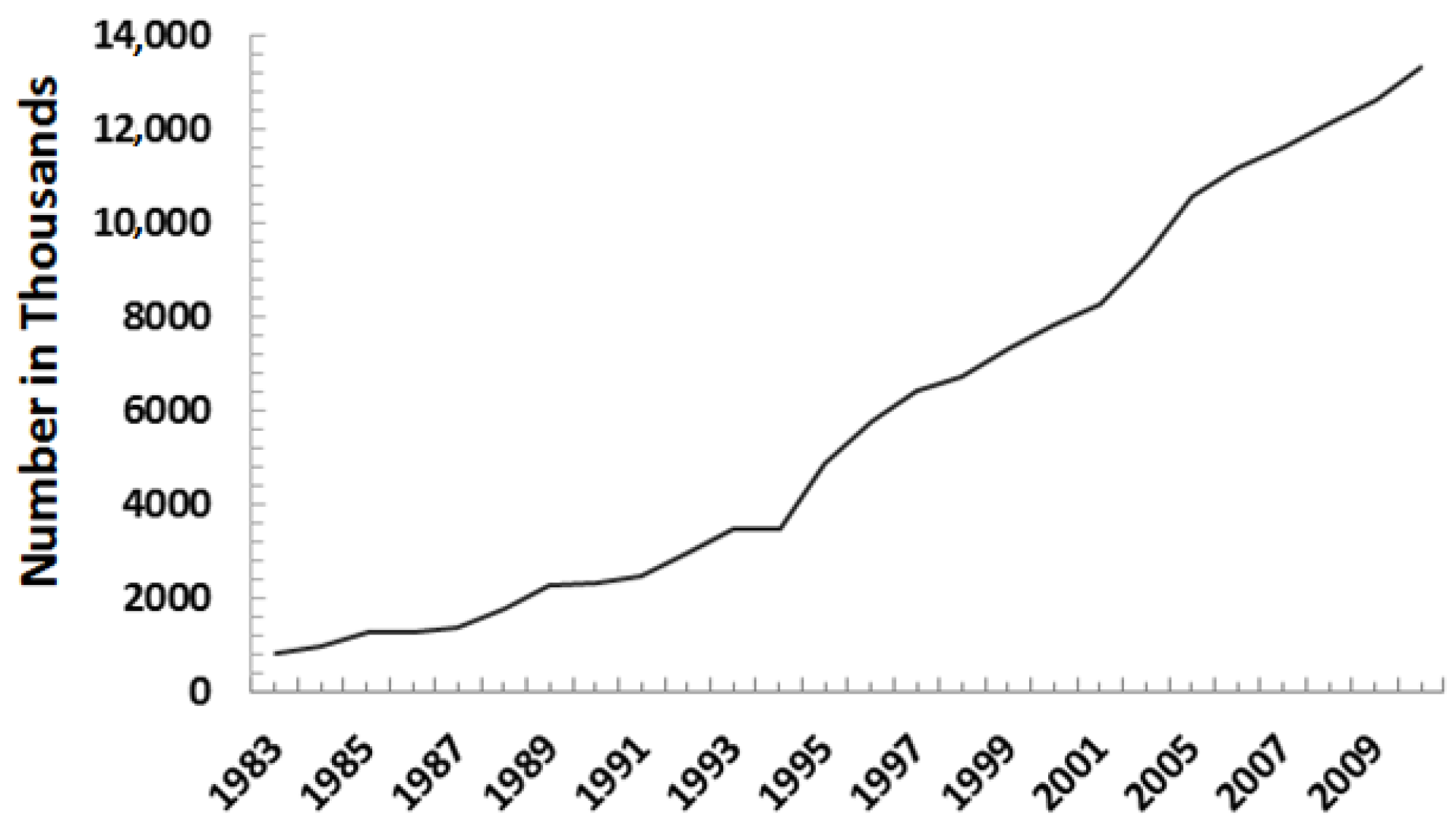



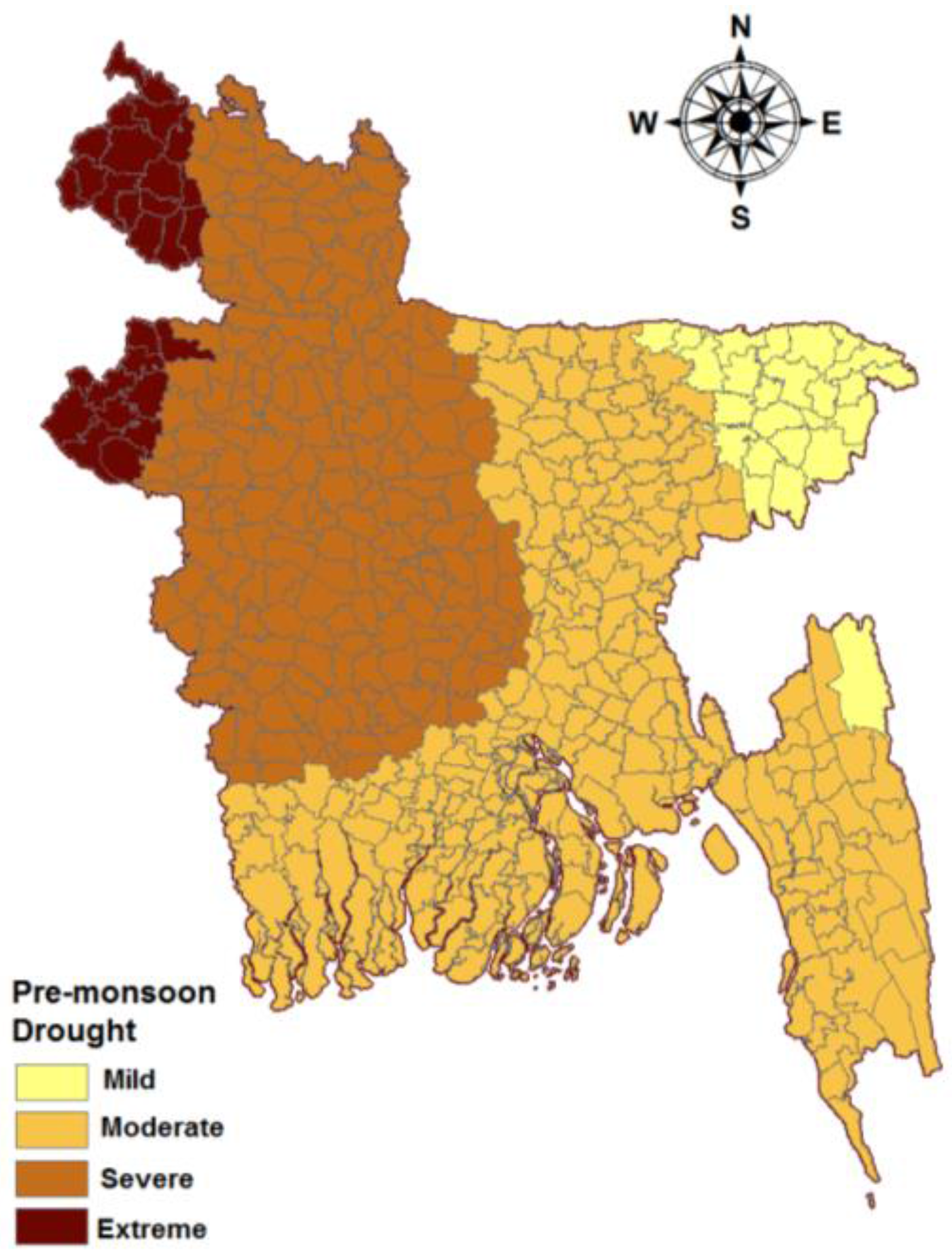
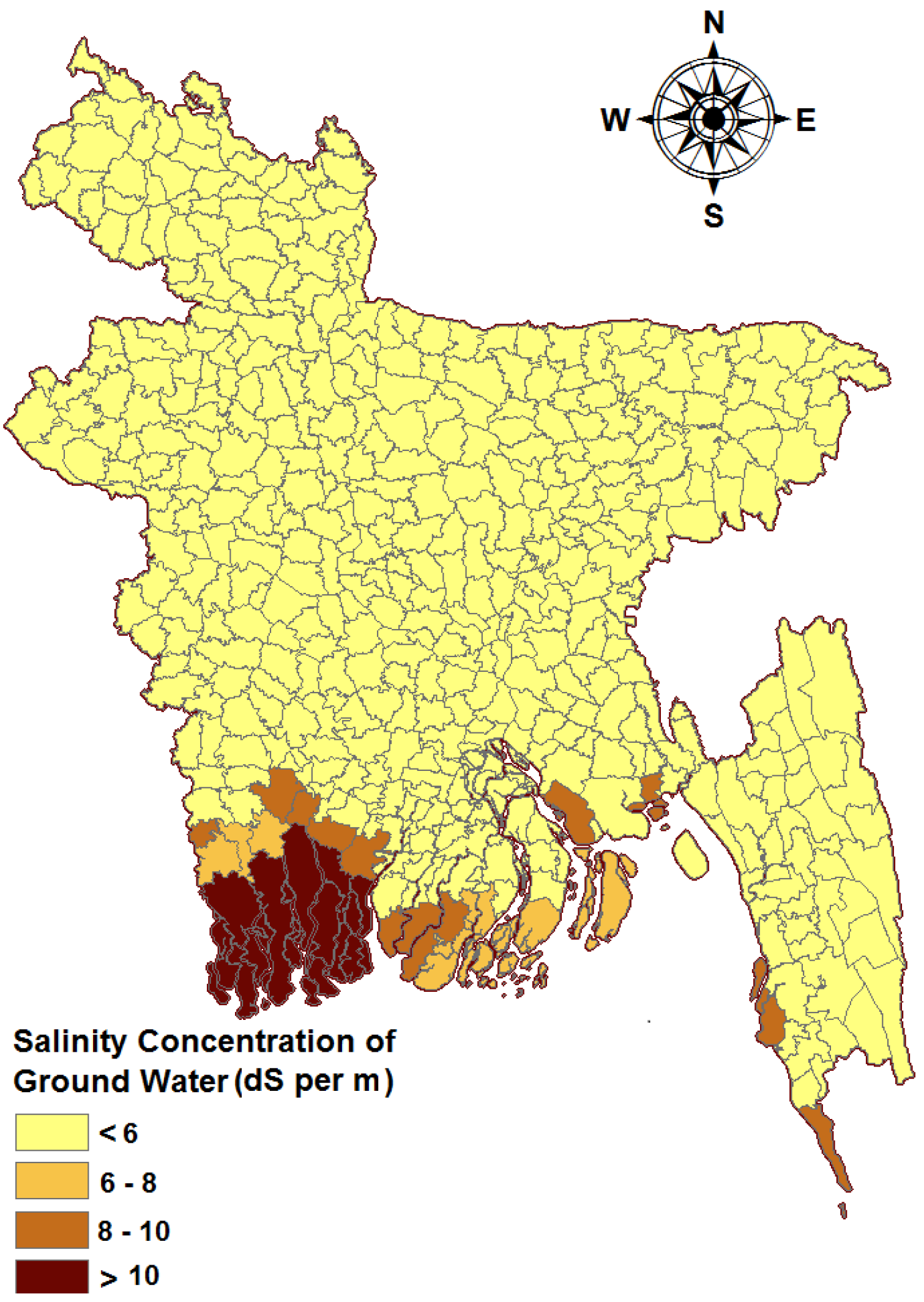
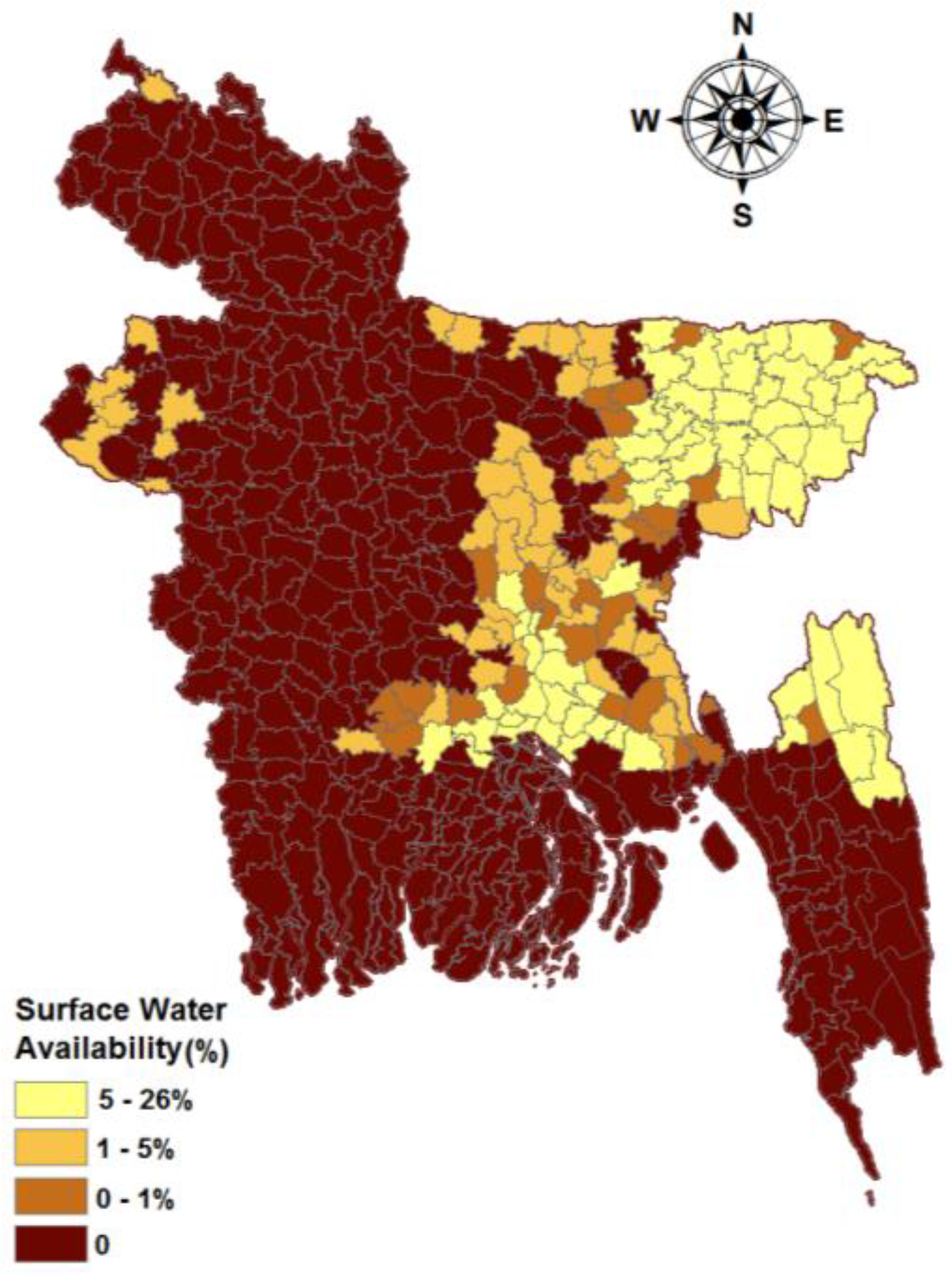
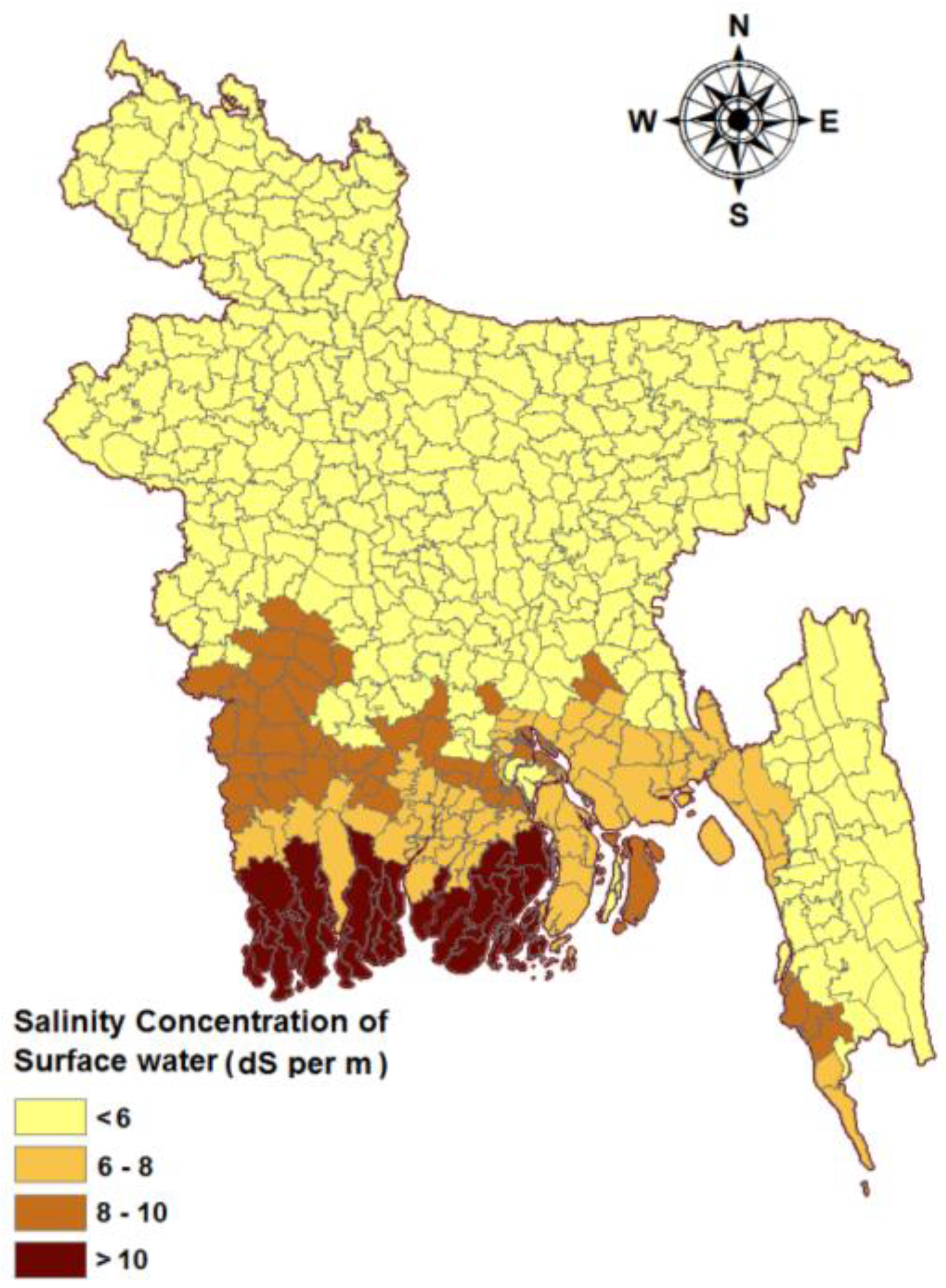
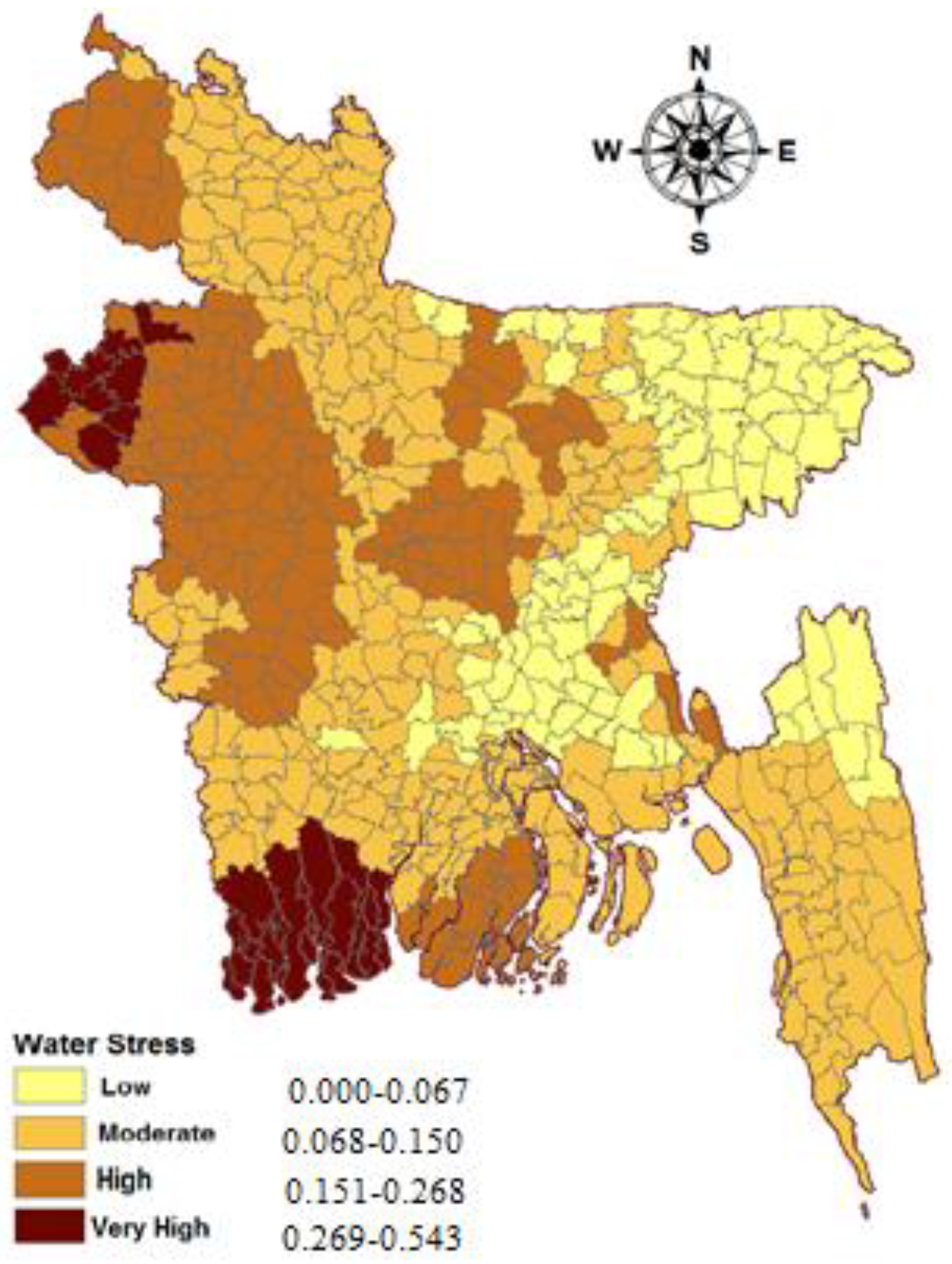
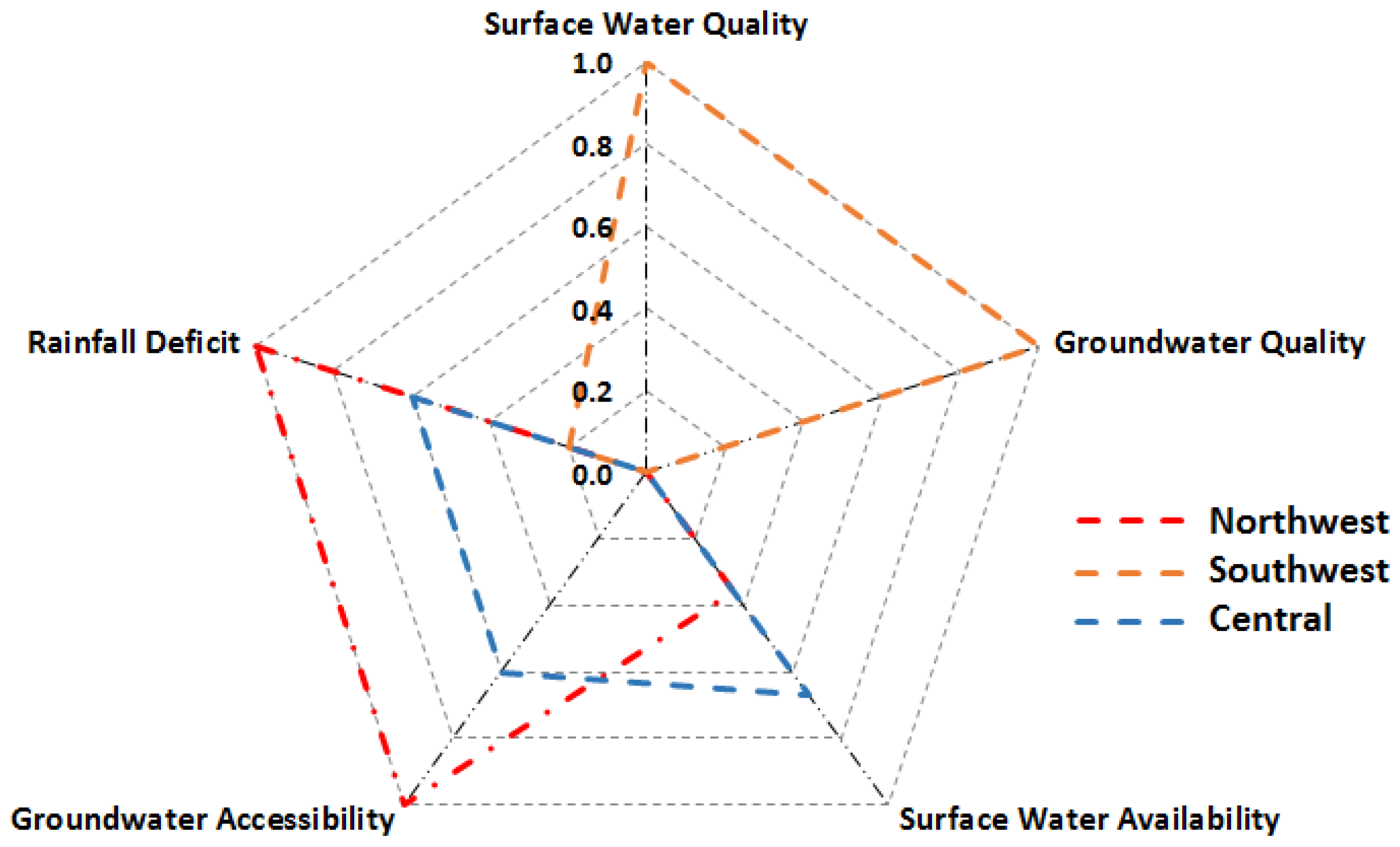
| Catastrophe Model | Control Parameters | State Variables | Potential Function |
|---|---|---|---|
| Fold | 1 | 1 | |
| Cusp | 2 | 1 | |
| Dovetail | 3 | 1 | |
| Butterfly | 4 | 1 | |
| Oval umbilici point | 3 | 2 | |
| Elliptic umbilici point | 3 | 2 | |
| Parabolic umbilici point | 4 | 2 |
| Sub-System | Indicator | Data |
|---|---|---|
| Pre−Monsoon Drought | Extreme | −2.5 to −2.25 |
| Severe | −2.25 to −2 | |
| Moderate | −2 to −1.75 | |
| Mild | −1.75 to −1.5 | |
| Groundwater Salinity (dS/m) | Mild | <6 |
| Moderate | 6 to 8 | |
| Severe | 8 to 10 | |
| Extreme | >10 | |
| Groundwater Depth (m) | Mild | <8 |
| Moderate | 8 to 10 | |
| Severe | 10 to 15 | |
| Extreme | >15 | |
| Surface Water Salinity (dS/m) | Mild | <6 |
| Moderate | 6 to 8 | |
| Severe | 8 to 10 | |
| Extreme | >10 | |
| Surface Water Availability (%) | Extreme | 0 to 0.13 |
| Severe | 0.14 to 0.42 | |
| Moderate | 0.43 to 0.72 | |
| Mild | 0.73 to 1 |
| System | Sub-System | Indicator | Data | Standardize | Weight |
|---|---|---|---|---|---|
| Agricultural Water Scarcity | Pre-Monsoon Drought | Extreme | −2.375 | 1 | 0.658 |
| Severe | −2.125 | 0.67 | |||
| Moderate | −1.875 | 0.33 | |||
| Mild | −1.625 | 0 | |||
| Groundwater Depth (m) | Extreme | 15 | 1 | 0.702 | |
| Severe | 12.5 | 0.8 | |||
| Moderate | 9 | 0.6 | |||
| Mild | 0 | 0 | |||
| Groundwater Salinity (dS/m) | Extreme | 0 | 0 | 0.715 | |
| Severe | 7 | 0.7 | |||
| Moderate | 9 | 0.9 | |||
| Mild | 10 | 1 | |||
| Surface Water Availability (%) | Extreme | 0.065 | 1 | 0.669 | |
| Severe | 0.28 | 0.73 | |||
| Moderate | 0.58 | 0.36 | |||
| Mild | 0.87 | 0 | |||
| Surface Water Salinity (dS/m) | Extreme | 0 | 0 | 0.715 | |
| Severe | 7 | 0.7 | |||
| Moderate | 9 | 0.9 | |||
| Mild | 10 | 1 |
© 2018 by the authors. Licensee MDPI, Basel, Switzerland. This article is an open access article distributed under the terms and conditions of the Creative Commons Attribution (CC BY) license (http://creativecommons.org/licenses/by/4.0/).
Share and Cite
Ahammed, S.J.; Chung, E.-S.; Shahid, S. Parametric Assessment of Pre-Monsoon Agricultural Water Scarcity in Bangladesh. Sustainability 2018, 10, 819. https://doi.org/10.3390/su10030819
Ahammed SJ, Chung E-S, Shahid S. Parametric Assessment of Pre-Monsoon Agricultural Water Scarcity in Bangladesh. Sustainability. 2018; 10(3):819. https://doi.org/10.3390/su10030819
Chicago/Turabian StyleAhammed, Sumaiya Jarin, Eun-Sung Chung, and Shamsuddin Shahid. 2018. "Parametric Assessment of Pre-Monsoon Agricultural Water Scarcity in Bangladesh" Sustainability 10, no. 3: 819. https://doi.org/10.3390/su10030819
APA StyleAhammed, S. J., Chung, E.-S., & Shahid, S. (2018). Parametric Assessment of Pre-Monsoon Agricultural Water Scarcity in Bangladesh. Sustainability, 10(3), 819. https://doi.org/10.3390/su10030819







